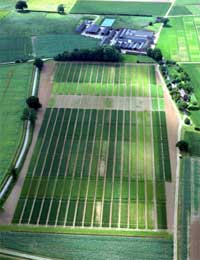Harpenden, United Kingdom
April 12, 2005
Scientists at
Rothamsted Research in
Harpenden and the University
of Reading have been able to recover DNA from crop diseases
on wheat samples stored as part of a Victorian field experiment.
Using this DNA, they have discovered how changes in air
pollution over the last 160 years have affected fungal diseases
on our wheat crops.
The most
damaging wheat disease in Europe is leaf blotch, caused by two
different fungal species, Phaeosphaeria nodorum and
Mycosphaerella graminicola. These species cause the loss of
millions of tonnes of grain worldwide each year. Changes in the
importance of these two species have been reported in the UK and
elsewhere but the reason for this has remained unclear.
 Dr
Bart Fraaije and his colleagues looked at straw samples archived
from the Broadbalk experiment (photo), the world’s oldest,
continually-running field experiment, which was set up in 1843
to investigate the effect of fertilisers on crop yields and the
soil. They were able to extract fungal DNA from the straw,
enabling them to carefully track changes in the populations of
the two fungi since Broadbalk’s inception over 160 years ago. Dr
Bart Fraaije and his colleagues looked at straw samples archived
from the Broadbalk experiment (photo), the world’s oldest,
continually-running field experiment, which was set up in 1843
to investigate the effect of fertilisers on crop yields and the
soil. They were able to extract fungal DNA from the straw,
enabling them to carefully track changes in the populations of
the two fungi since Broadbalk’s inception over 160 years ago.
Their
results, which are published today, showed that changes in the
relative abundance of the diseases are strongly linked to
changes in the atmospheric emissions of sulphur dioxide (SO2).
As SO2 emissions rose during and after the industrial
revolution, P. nodorum became abundant, whilst M.
graminicola was scarce. However, coal burning has declined
dramatically over the past 20 years, leading to a decline in SO2
emissions and the situation is now reversed, with M.
graminicola more common.
Pollutants
are known to affect both plants and the diseases that attack
them. “Gardeners have long suspected that reduced air pollution
is to blame for the increase in black spot on their roses,” says
Bart Fraaije “but you need a long term data set, such as that
generated by the Broadbalk experiment, if you are going to
investigate such associations more rigorously. Similar research
on a wider range of organisms would help us to assess the impact
of environmental change on biodiversity or to predict disease
outbreaks.” |